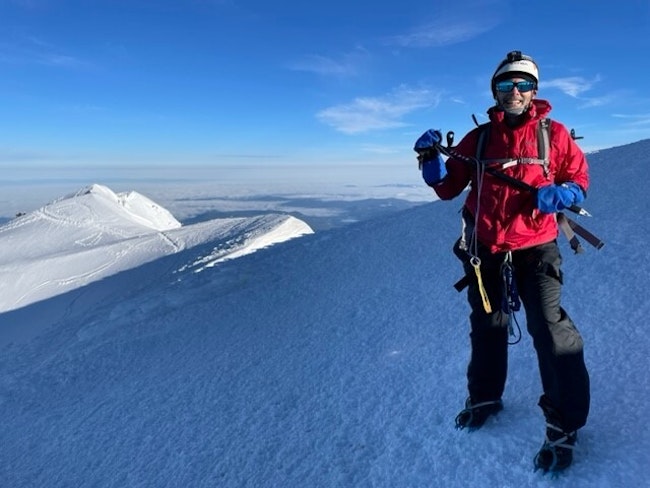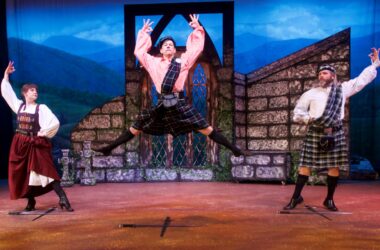 Michael Dunne, on Mt. Hood’s summit.
Michael Dunne, on Mt. Hood’s summit.
 Michael Dunne in Oregon Health and Science University Hospital in Portland after his fall down Mt. Hood.
Michael Dunne in Oregon Health and Science University Hospital in Portland after his fall down Mt. Hood.
There’s an adage in mountaineering which states that after you reach the summit, the hard part really begins.
On May 24th, at around 7 a.m., I fulfilled a bit of a bucket list item by reaching the top of Oregon – the 11,239-foot summit of Mt. Hood.
The view from the summit was breathtaking, and I was excited that I was finally able to check that one off the list. As I high-fived my climbing partners and snapped pictures, I already had thoughts of a warm meal and celebration with my family.
Except that darn hard part was about to begin.
The climb of Hood is not a strictly technical endeavor, but it does take skill – especially up and down the two steep chutes that lead to and from the summit on the south side of the mountain – the Old Chute and the Pearly Gates. While successfully ascending the Old Chute to the summit, it soon became painfully clear that the Pearly Gates wasn’t going to be a heavenly entrance for me.
After uneventfully downclimbing the first section of the narrow gully, I transitioned off the safety rope to begin the final descent on the less steep section. Relying on my ice axe and crampons, I began lowering myself toward the bottom of the chute when suddenly my left boot decided to slip completely off my foot and fling itself down the mountain.
Stuck without a good purchase in the ice from my left side, I tried to lean into my ice axe, only to have it slip out as well. Gravity did the rest and soon I was sliding, bouncing and “rag-dolling” for about 600 agonizing feet.
When I finally came to rest, I first took stock of the facts that: A. I was alive. B. I was hurt. C. I was alive.
A climber from another party named Andy quickly came to my aid and the first thing I remember him saying was: “I’ve never seen a wipeout as bad as that.”
It was a first for me as well.
Pain radiated from my lower back, ribs, wrist and ankle. One look from Andy told me that the burning sensation around my face meant I had a stunning case of road rash from hitting my face repeatedly on the unforgiving ice.
Not good. Not good at all.
Yet amid my pain and fear, some really good things were about to happen.
You see this tale is not so much about my fall or my recovery. It’s about how good and decent people can be when someone – even a complete stranger – needs help.
That someone was me, and the many good people on the mountain that day not only helped me, but they also restored my faith in people.
First, there was Andy. A veteran climber, who along with his climbing partner Julio, not only cared for me after my fall, but also stayed with me and kept me warm and hydrated while we waited hours for the rescue team to reach us. They built me a platform to sit on, wrapped me in space blankets and kept evaluating me for shock. They had their entire day delayed and delayed, yet they not only stayed with me, they kept my spirits up during some of the worst hours of my life.
My climbing team – Dalen, Patrick and Mark – made the initial 9-1-1 calls and helped start the rescue process. They also talked with my wife and gave her instructions on where to come and meet me when I finally got down the mountain. My wife Karen, by the way, was a rock during this entire ordeal.
During the wait for rescue, there were at least seven individuals who stopped by to offer help and support. “Do you need water, food, hand warmers…” they would ask.
One woman whose name I didn’t get handed me a ground pad so I could sit up above the snow for greater comfort and to minimize the risk of hypothermia.
“I won’t be able to get this back to you,” I said. “No worries,” she said and then headed downslope.
Not long after, a young man who was skiing down toward Timberline Lodge stopped in front of us, pulled a down jacket out of his pack and handed it to me.
“I can’t take this, you might need it,” I said. “Naw,” he replied, “you need it more. I can always get another one.”
And then he was off down the mountain as well. Later I would see that the jacket he gave me was a genuinely nice item of clothing that probably cost $400 new.
Then the Hood River Crag Rats came over the horizon. This all-volunteer team of mountain rescuers – the oldest mountain Search & Rescue organization in the U.S. – started arriving and devising a rescue plan with military precision. Within minutes they assembled a sled and loaded me into a special type of inflatable sleeping bag to aid in my comfort. Before my pain-addled brain could comprehend what was happening, I was being whisked downhill with one skier in front, one in the back and a pack of rescuers on the flanks of the sled. Every single one of these volunteers had to ascend 2,000 feet up Mt. Hood for hours to reach me and affect a rescue.
In fact, after I was loaded into the waiting ambulance in the Timberline Lodge parking lot, I looked over to my left and saw that one of the Crag Rats was attending to me. His “real” job is a paramedic, yet he had to start his day with a grueling trudge up Oregon’s highest mountain to help me!
By the time we arrived at Oregon Health and Science University Hospital, it became readily apparent my fall had done a rather good job on my 50-something body. And even though I was in pain and starting to feel sorry for myself, I felt immense gratitude for the care I was receiving.
I know most people have had occasion to visit an emergency room in their lives, but I’m sure a smaller number have gone to a Level 1 trauma center. Believe me, there is a difference.
The efficiency of the care is amazing. It was like a conveyor belt of analysis, CAT scan imaging, X-rays and treatment. But more than that, it was the kind and gentle professionalism that struck me most.
These doctors and nurses see so much pain and suffering, often because of violence, but the kindness and humor that they showed me and my wife was truly amazing.
With the final diagnosis of fractures to my wrist, two ribs and ankle, along with some bruising and superficial abrasions, the decision was conveyed to me that we could leave that night and begin recuperating at home.
As a young nurse started helping me with final preparations to leave, she confided in me that she wanted to see how I was doing because she heard about the cause of my injuries and that she is a climber herself. In fact, she had just successfully summited Mt. Hood the day before I did.
When I told her about the amazing help and kindness I received, she told me she wasn’t too surprised. “We mountain climbers tend to look out for one another.”
And so it was that we left Portland and headed for home. I was battered, bruised, and hurting, but I was also buoyed by human kindness and the knowledge that when the chips are down, we help one another.
Email: [email protected]








